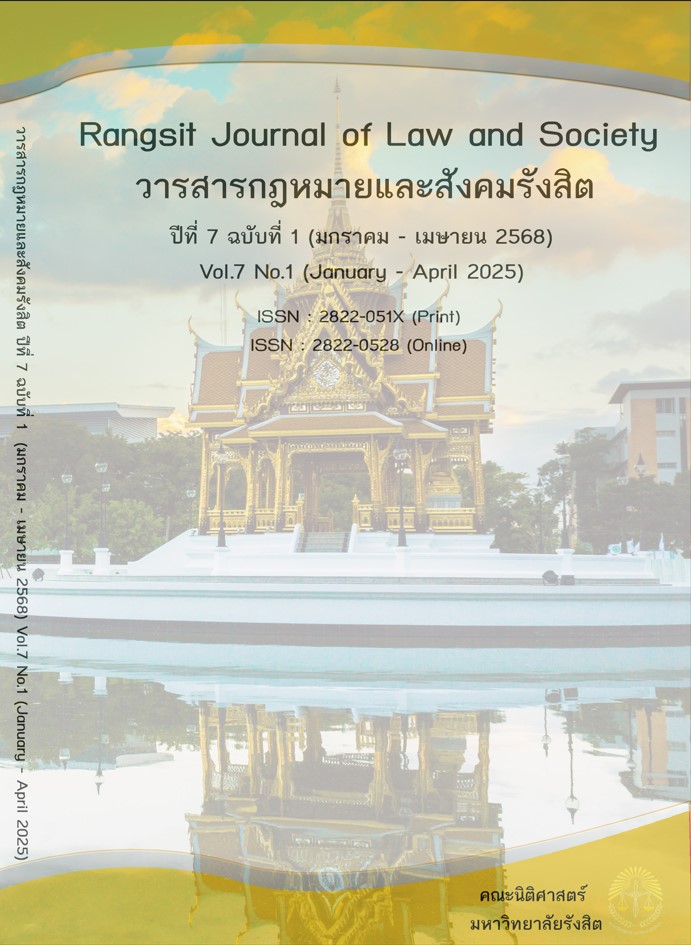COMMUNICATION COMPETENCE OF EXECUTIVES IN MOTIVATING WORKFORCE IN LOCAL ADMINISTRATION -
Main Article Content
Abstract
The communication competence of executives played a very significant role in creating workforce motivation and performance in local administrative organization. However, problems arising from communication among executives in local administrative organizations were important issues that affected the efficiency of operations within the organization, which possibly led to misunderstandings and work performance that did not meet the goals or reduced work efficiency. This article thus aimed to find an effective communication model for executives to motivate personnel in the organization. It was found that an organization’s executives with high communication skill could lead to a clear understanding of the organization’s goals and directions with personnel. High communication skill was an important part of motivating personnel to be proactive and participate in driving the organization. The use of diverse and modern communication channels, the use of technology, and face-to-face communication were important mechanisms for building trust among personnel in an organization. In addition, creating an atmosphere of open and transparent communication was very crucial to stimulate cooperation and develop the working potential of personnel in the organization. It helped to reduce conflicts and increased efficiency in working together to drive local administrative organizations sustainably.
Article Details

This work is licensed under a Creative Commons Attribution-NonCommercial-NoDerivatives 4.0 International License.
References
เกรียงศักดิ์ แสงสว่าง. (2566). ภาวะผู้นำและวัฒนธรรมองค์กรที่มีอิทธิพลต่อแรงจูงใจในการปฏิบัติงานของบุคลากรองค์การบริหารส่วนจังหวัดปทุมธานี. วารสารวิชาการการจัดการภาครัฐและเอกชน คณะบริหารธุรกิจและรัฐประศาสนศาสตร์ มหาวิทยาลัยเวสเทิร์น, 5(1), 113-127.
เอกกร มีสุข และคณะ. (2567). การสื่อสารของผู้บริหารองค์กรปกครองส่วนท้องถิ่นในการสร้างวัฒนธรรมองค์กรที่เป็นเลิศ. Journal of Roi Kaensarn Academi, 9(7), 1164–1185.
เอกกร มีสุข และคณะ. (2567). การสื่อสารคุณลักษณะของผู้บริหารองค์กรปกครองส่วนท้องถิ่นเพื่อสร้างความนิยมทางการเมืองในพื้นที่ภาคใต้. วารสารสันติศึกษาปริทรรศน์ มจร., 12(4), 1310-1325.
เอมอร เสือจร และคณะ. (2567). การนำนวัตกรรมด้านเทคโนโลยีดิจิทัลมาประยุกต์ใช้เพื่อเพิ่มประสิทธิภาพในการปฏิบัติงาน กรณีศึกษา กองส่งเสริมและพัฒนาการจัดการศึกษาท้องถิ่น กรมส่งเสริมการปกครองท้องถิ่น. วารสารรามคำแหง ฉบับรัฐประศาสนศาสตร์, 7(1), 285–315.
ปวีร์รวี อินนุพัฒน์ และคณะ. (2567). การสื่อสารของผู้นำองค์กรปกครองส่วนท้องถิ่นเพื่อสร้างองค์กรดิจิทัล. วารสารสังคมศาสตร์และวัฒนธรรม, 8(11), 150-162.
ภวัต พัฒนนิภากร และเสาวลักษณ์ โกศลกิตติอัมพร. (2562). บทบาทองค์กรปกครองส่วนท้องถิ่นสู่ไทยแลนด์ 4.0. วารสาร มจร. อุบลปริทรรศน์, 4(1), 1-20.
มุทิตา ภู่ระหงษ์. (2564). การสื่อสารของผู้บริหารที่ส่งผลต่อประสิทธิผลในการบริหารงานขององค์การบริหารส่วนตำบลในจังหวัดสุราษฎร์ธานี. วารสารวิชาการมหาวิทยาลัยปทุม, 13(1), 309-327.
ยงยุทธ นุฤทธิ์มนตรี และคณะ. (2565). ภาวะผู้นำดิจิทัลของผู้บริหารในองค์กร. วารสารวิทยาลัยบัณฑิตเอเซีย, 12(4), 186-206.
ยุภา นารินนท์. (2563). ผู้นำท้องถิ่นกับการสื่อสาร. วารสารมนุษยศาสตร์และสังคมศาสตร์ มมร. วิทยาเขตอีสาน, 1(3), 38-44.
สำรวย พยอมใหม่. (2565). การติดต่อสื่อสารที่ส่งผลต่อประสิทธิผลการบริหารงาน ขององค์กรปกครองส่วนท้องถิ่นในจังหวัดนครราชสีมา. วารสารมหาจุฬานาครทรรศน์, 9(7), 319-336.
สิทธิพันธ์ พูนเอียด. (2568). การสื่อสารเพื่อเสริมสร้างการบริหารจัดการองค์กรที่ดีของผู้บริหารองค์กรปกครองส่วนท้องถิ่น. ใน วิทยานิพนธ์ปรัชญาดุษฎีบัณฑิต สาขาวิชานิเทศศาสตร์. กรุงเทพมหานคร: มหาวิทยาลัยสุโขทัยธรรมาธิราช.
ออระญา ปะภาวะเต และบุญชม ศรีสะอาด. (2564). แนวทางการพัฒนาภาวะผู้นำยุคดิจิทัลของผู้บริหารสถานศึกษา สังกัดสำนักงานเขตพื้นที่การศึกษาประถมศึกษาบุรีรัมย์ เขต 2. Journal of Modern Learning Development, 6(4), 191-200.
A. T. Himmelman. (2001). Collaboration for a change: Definitions, decision-making models, roles,and collaboration process guide. Minneapolis: Himmelman Consulting.
C. Arin and W. Papitchaya. (2023). Enhancing effective employee communication through organization development process to improve teamwork: a case study of a faculty at a private university. Panyapiwat Journal, 15(3), 105-121.
C. R. Rogers and R. E. Farson. (1987). Active listening. Chicago: University of Chicago Industrial Relations Center.
J. A. Nielsen and H. H. Salomonsen. (2012). Why all this communication? Explaining strategic communication in Danish local governments from an institutional perspective. Scandinavian Journal of Public Administration, 16(1), 69–89.
J. Brownell. (2012). Listening: Attitudes, principles, and skills (5th ed.). Pearson.
K. Rajhans and T. Shome. (2016). The impact of organizational communication satisfaction on employee productivity. International Journal of Applied Marketing and Management, 1(1), 13-23.
M. M. Musheke and J. Phiri. (2021). The effects of effective communication on organizational performance based on the Systems Theory. Open Journal of Business and Management, 9(2), 659-671.
N. Y. Zulkeifli, et al. (2023). Communication as a Strategy in Enhancing an Organization Performance. International Journal of Academic Research in Business and Social Sciences, 13(10), 2228-2235.

